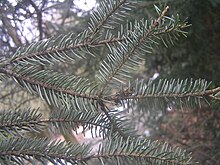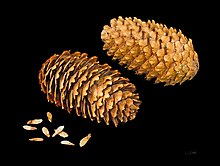Likiang spruce
| Likiang spruce | ||||||||||||
|---|---|---|---|---|---|---|---|---|---|---|---|---|

Likiang spruce ( Picea likiangensis ) |
||||||||||||
| Systematics | ||||||||||||
|
||||||||||||
| Scientific name | ||||||||||||
| Picea likiangensis | ||||||||||||
| ( Franch. ) E. Pritz. |
The Likiang spruce ( Picea likiangensis ) is a species from the pine family (Pinaceae). It is native to eastern Asia .
description
The Likiang spruce grows as an evergreen tree that can reach stature heights of up to 50 meters and diameters of up to 2.5 meters at chest height . The trunk ends in a pyramidal crown . The gray to brown-gray trunk bark flakes off in irregularly shaped, thick plates. The sparsely hairy bark of the branches is initially pale yellow or brownish yellow and turns gray to gray-yellow over time.
The resinous, brown winter buds are conical, egg-shaped or spherical in shape. The straight or slightly curved needles are linearly shaped with a length of 0.6 to 1.5 centimeters and a width of 1 to 1.5 millimeters. They have a broad, diamond-shaped cross-section and their tip is blunt or tapered. There are four to seven stomatal lines on the top of the needle and up to four on the bottom of the needle .
The Likiang spruce is single-sexed ( monoecious ) and the flowering period extends from April to May. The cones are elongated-egg-shaped to cylindrical-egg-shaped with a length of 4 to 12 centimeters and a thickness of 1.7 to 3.5 centimeters. They are initially reddish brown over red to purple in color and turn brown to dark purple until they are ripe in September or October. The seed scales are oval-diamond-shaped and 1.5 to 2.6 inches long and 1 to 1.7 inches wide. Their edge is serrated or wavy. The gray-brown, approximately egg-shaped seeds become 0.7 to 1.4 centimeters long together with the seed wing. The oblong, obverse-shaped seed wing is glossy pale brown in color and mostly has purple speckles.
The number of chromosomes is 2n = 24.
Distribution and location
The natural range of the Likiang spruce is in Bhutan and China. In China, the species is found in southern Qinghai , southern and western Sichuan , eastern Xizang and northwestern Yunnan .
The Likiang spruce thrives at altitudes of 2500 to 4100 meters. It grows mainly in mountains, in ravines and in river valleys. Mixed stands are usually formed with firs ( Abies ), with Larix potaninii , the Sargent spruce ( Picea brachytyla ) and with various hemlocks ( Tsuga ).
The Likiang spruce and the rubescens variety are classified as "endangered" in the IUCN Red List . The hirtella variety is listed as "highly endangered" while the montigena variety is not classified in any hazard category due to insufficient data. The main risk mentioned is logging. The total population of the species has shrunk by around 30 percent in the last 75 years. For this reason, the Chinese government has banned this type of hunt in western China.
use
The wood of the Likiang spruce is used as construction and furniture wood as well as for the production of machines, masts and cellulose. Are from the bark tannins , of the tribe of resin obtained from the needles and aromatic oils.
Systematics
Picea likiangensis is assigned to the subgenus Casicta , the Sitchenses section and the Likiangenses series within the genus of the spruce trees ( Picea ) .
The first description as Abies likiangensis was in 1899 by Adrien René Franchet in Journal de Botanique (Morot) , Volume 13 (8), page 257. Ernst Georg Pritzel transferred the species in 1900 in Botanical Yearbooks for Systematics, Plant History and Plant Geography , Volume 29 ( 2), page 217 in the genus Picea .
The species is divided into up to five varieties :
- Picea likiangensis var. Hirtella W.C. Cheng occurs in western Sichuan and southeastern Xizang , where it grows at altitudes of 3,000 to 4,000 meters. It has three to four stomatal lines on the underside of the needle. The 4 to 9 centimeters large cones are initially green-yellow or yellow and turn pale brown-yellow as they mature. A synonym is Picea hirtella Rehder & EH Wilson nom. illegal.
- Picea likiangensis var. Likiangensis is the nominate form . It occurs almost in the entire range.
- Picea likiangensis var. Linzhiensis W.C. Cheng & LK Fu occurs in southwest Sichuan , southeast Xizang and northwest Yunnan , where it grows at altitudes of 2900 to 3700 meters. The 5 to 10 centimeters large cones are colored pale purple to reddish brown shortly before they are ripe. It is also considered by some authors as an independent species Picea linzhiensis (WCCheng & LKFu) Rushforth .
- Picea likiangensis var. Montigena (Mast.) WC Cheng occurs in southwestern Sichuan , where it grows at altitudes of over 3300 meters. It has one to four stoma lines on the underside of the needle. The 4 to 9 centimeters large cones are colored green before maturity. Picea montigena mast is a synonym .
- Picea likiangensis var. Rubescens Rehder & EH Wilson occurs in southern Qinghai , southern Sichuan and eastern Xizang , where it grows at altitudes of 3,000 to 4,100 meters. It has three to four stomatal lines on the underside of the needle. The 4 to 9 centimeters large cones are initially red-brown or black-violet and turn brown to black-brown as they mature.
swell
- Christopher J. Earle: Picea likiangensis. In: The Gymnosperm Database. www.conifers.org, November 23, 2012, accessed October 30, 2013 (English).
- Liguo Fu, Nan Li, Thomas S. Elias & Robert R. Mill: Pinaceae . Picea. In: Wu Zhengyi, Peter H. Raven & Hong Deyuan (eds.): Flora of China . Cycadaceae through Fagaceae. Volume 4. Science Press and Missouri Botanical Garden Press, Beijing and St. Louis 1999, ISBN 0-915279-70-3 , Picea likiangensis , pp. 29 (English, Picea likiangensis - online - this printed work is online with the same text).
Individual evidence
- ↑ a b c d e Christopher J. Earle: Picea likiangensis. In: The Gymnosperm Database. www.conifers.org, November 23, 2012, accessed October 30, 2013 (English).
- ↑ a b c d e f g h i j Liguo Fu, Nan Li, Thomas S. Elias & Robert R. Mill: Pinaceae . Picea. In: Wu Zhengyi, Peter H. Raven & Hong Deyuan (eds.): Flora of China . Cycadaceae through Fagaceae. Volume 4. Science Press and Missouri Botanical Garden Press, Beijing and St. Louis 1999, ISBN 0-915279-70-3 , Picea likiangensis , pp. 29 (English, Picea likiangensis - online - this printed work is online with the same text).
- ↑ a b c Picea likiangensis at Tropicos.org. Missouri Botanical Garden, St. Louis, accessed August 1, 2016.
- ↑ a b Picea likiangensis in the endangered Red List species the IUCN 2013 Posted by: D. Zhang, A. Farjon, T. Christian, 2010. Accessed October 30, 2013.
- ↑ Picea likiangensis var. Rubescens in the endangered Red List species the IUCN 2013. Posted by: A. Farjon, T. Christian, 2010. Accessed October 30, 2013.
- ↑ Picea likiangensis . Var hirtella in the Red List of Threatened Species of the IUCN 2013. Posted by: Q. Xiang, T. Christian, A. Farjon, 2010. Accessed October 30, 2013.
- ↑ Picea likiangensis var. Montigena in the Red List of Threatened Species of the IUCN 2013. Posted by: D. Zhang, T. Christian, 2010. Retrieved October 30, 2013.
- ↑ Picea likiangensis. In: The Plant List. www.theplantlist.org, accessed October 30, 2013 .
- ↑ Rafaël Govaerts (ed.): Picea. In: World Checklist of Selected Plant Families (WCSP) - The Board of Trustees of the Royal Botanic Gardens, Kew . Retrieved April 16, 2019.

